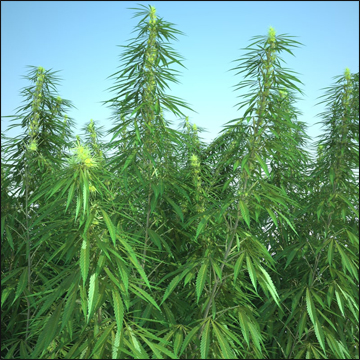What are the Uses and Health Benefits of Bhang (Cannabis Sativa)?

What is Bhang (Cannabis Sativa)?
Cannabis sativa is also known as Cannabis indica. It is an annual herb which belongs to family Cannabinaceae. It is native to central Asia, China, and Europe. It has been used in Ayurveda and in some Indian festival drinks since many ages. In Ayurvedic system of medicine, it is used for treating insomnia, low digestive strength, and IBS.
This herb is grouped under Upavisha (sub-toxic herbs). Purification is required before its usage.
Description
It is an annual herb that grows up to the height of 3 to 10 feet (10 cm) in length and 1.5 cm wide or even more than that. It is slightly branched with greyish green colored hair. Leaves are palmate, and have long petioles. These are dark green in color with serrate, 3 to 10 in numbers, and have acuminate leaflets.
The ovary of the flowers of this herb is one. The male stigmas have five segments with pale yellow color.
Names in Different languages
- English: Indian Hemp, Marijuana
- Hindi: Bhang
- Kannada name: Bhangisoppu
- Tamil name: Bangii
- Gujrati name: Bhag
- Telgu name: Gunjai
- Farsi name: Kinnab
- Bengali name: Bhang, ganja and siddi
- Turkish name: Hind heneviri
- Swedish name: Tlamp
- Arabic name: Kanab, Hinab, kinnab
- Assami name: Dai ma
- Chinese name: Tama, fuma, ma, tang ma
Sanskrit Synonyms:
- Vijaya, Ganja, Ganjayika
- Bhangika, Indrasana
- Madani, Matulani
Chemical Constituents Present in Cannabis
Cannabidiol, tertahydro- cannabiol, cannabinol, I-dehydro-tetrahydrocannabinol, cannabinodis, eugenol etc.
Cannabis and Ayurveda
In Sanskrit language, cannabis is known as bhanga and it has a long history of being used as a medicine in Ayurveda. It is classified under the toxic substances by the ancient texts on Ayurvedic herbs and it has been used for healing purposes after purification. Chakradatta has revealed this herb in the kushtha chikitsa that eliminates the skin’s bacteria from the body.
A person who is a believer of Lord Shiva, uses this herb as the prasad on the celebration of festival Maha Shivratri. The solution of the bhang leaves and guava, almond, milk and other herbs are prepared on this day. Bhang pakoda is one of the most famous dishes and usually found everywhere on Maha Shivratri.
What are the Properties of Cannabis?
- Rasa (Taste): Tikta (Bitter)
- Guna (Qualities): Laghu (Light), Teekshna (Strong), Vyavayi (Spreads to Different Parts of the Body)
- Veerya (Potency): Ushna (Hot)
- Vipaka: Katu (Undergoes Pungent Taste Conversion After Digestion.
- Karma (Effect on Doshas): Balance Vata and Kapha Dosha
Part Used
Leaves
What are the Medicinal Uses of Cannabis?
- Cannabis increases the pitta dosha (Pittala)
- This herb acts as an absorbent and useful in IBS and diarrhea (Grahi)
- Obese people can use cannabis as it reduces weight (karshani)
- Being an appetizer, it improves the digestion strength (Deepana)
- It also has an intoxication effect. (Madakrut)
- It induces sleep (Nidrakaraka)
- In low dosage, it treats glaucoma, epilepsy, convulsions, and schizophrenia
- It is also useful in treating multiple sclerosis by relieving pain, inflammation, and spasm.
External Uses:
- Leaves of cannabis are applied on the affected part to relieve pain and increase the warmth. It is also useful in atopic dermatitis and in infected wounds. Its paste is applied over the pile mass to shrink it as it relieves pain and itching.
Purification process of cannabis (Bhanga Shodhana):
- Before using it, cannabis is subjected to the purification procedure.
- Leaves of cannabis are tied in cloth and boiled in the milk for 3 to 4 hours. After that, it is fried in ghee. After this procedure, it is used for medicinal procedures.
Side Effects
- It is unsafe to use during pregnancy and lactation and in children
- It should not be used in High BP and people who are susceptible to a heart attack should avoid using it.
Its long term use may cause the following side effects:
- Decreases respiratory immunity and may cause depression
- Lowers the level of testosterone, decreases sperm quality and count
- Most of the side effects are seen in persons with low BP, diabetes, and liver-related disorders.
Healing Properties of Cannabis according to the Ayurveda
Cannabis is pungent, astringent and bitter in taste. It has narcotic qualities. When it is used in the proper dosage, it decreases the vitiated Kapha dosha and increases pitta dosha which simultaneously increases the digestive fire. But in rare cases, it may cause constipation. This herb has the potential to heal the reproductive tissues. It also treats conditions related to the respiratory and digestive tract and other disorders such as IBS, ulcerative colitis, fever, sprue syndrome, etc. and also used as a health tonic. Due to its intoxicating qualities, it has been used as a pain-killer in Ayurveda since ancient times.



